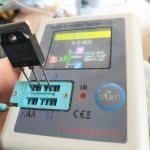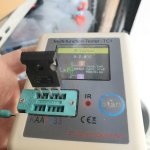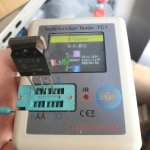I test each part for beta and leakage in both modes as a minimum. If I suspect a fake, I measure junction capacitances and one tester measures Ft. But I buy from authorized distributors, so I normally only see fakes in equipment repaired by others.
I drive them into clipping since the input and output behavior at clipping varies enormously between different types/designs of op-amps. That combined with the slewing behavior provides a nice signature in one picture.
Just to put some historical prospective on this subject. One of my uncles worked post WWII at General Electric in Lynchburg VA. Spent decades as the head of semiconductor engineering. Even back then. Transistors from the same vendor would work in production. Then they would get a batch that would not work as designed! His job was to get his team to figure out why. Supply the results back to the manufacture. And keep production running! Now we are ******* up a rope wasting time sorting out counterfeit parts! Sad state of affairs but true.
Hi prosys,
Back then, production variances were large. Processes weren't well controlled as they are today. Even in the 1980's buying premium parts, I had to buy lots of 10 to get decent matched pairs. Today I can buy 10 and have one or two "fliers", and even they are well within the criterion for a good match compared to even 1990.
Semi's have enjoyed a steady improvement in production quality. So have vacuum tubes (but it is the Russians there). But your point is well taken. There is zero excuse for a fake or poor semiconductor. We can take a semi, strip it layer by layer and reproduce it. It's also pretty easy to measure batches to get the actual performance specs. Motorola was doing it in the 1960's and I haven't checked earlier. Same for GE and RCA, Fairchild and everyone else back then.
It boils down to a quick buck, and this is really a crime.
Back then, production variances were large. Processes weren't well controlled as they are today. Even in the 1980's buying premium parts, I had to buy lots of 10 to get decent matched pairs. Today I can buy 10 and have one or two "fliers", and even they are well within the criterion for a good match compared to even 1990.
Semi's have enjoyed a steady improvement in production quality. So have vacuum tubes (but it is the Russians there). But your point is well taken. There is zero excuse for a fake or poor semiconductor. We can take a semi, strip it layer by layer and reproduce it. It's also pretty easy to measure batches to get the actual performance specs. Motorola was doing it in the 1960's and I haven't checked earlier. Same for GE and RCA, Fairchild and everyone else back then.
It boils down to a quick buck, and this is really a crime.
Thanks for your reply in this ultra long thread. Yes good a point every aspect of semiconductors have improved. Also counterfeit parts is an organized crime often on a mass scale! One of my clients the simple Motorola 2N3819 FET. It has be posted that the counterfeit parts test as PNP transistors! As well as TDA1518BQ amp chips in the same unit.
The practice of faking or remarking jellybean TO-92’s has to be an all time low. You have to sell MILLIONS of them to make any money. I guess the market really is THAT big. I wouldn’t have believed it myself until an MPSA06 tested PNP.
lol!
You can't trust anything. They sell transistors by the train box car load.
I simply stopped buying anything that doesn't come from an authorized distributor decades ago, or from a shop where I know they got them from distribution. In very special cases, yes, but then I test the heck of of those parts as I cannot trust them until proved to be authentic. This is even true of special purpose integrated circuits where there isn't any known sub.
What are these counterfeiting people thinking? It is pure scam, crime with intent.
You can't trust anything. They sell transistors by the train box car load.
I simply stopped buying anything that doesn't come from an authorized distributor decades ago, or from a shop where I know they got them from distribution. In very special cases, yes, but then I test the heck of of those parts as I cannot trust them until proved to be authentic. This is even true of special purpose integrated circuits where there isn't any known sub.
What are these counterfeiting people thinking? It is pure scam, crime with intent.
Well, that would be nice. It would seem to be a nod to CDIL's quality.
Now as long as CDIL maintains quality across their products - GREAT! But you can only bet on quality with licensed numbers, even then it only means legal action should quality control slip. Just like in any other fab on he planet. And a massive hit to their reputation. Smart management wouldn't risk that.
Now as long as CDIL maintains quality across their products - GREAT! But you can only bet on quality with licensed numbers, even then it only means legal action should quality control slip. Just like in any other fab on he planet. And a massive hit to their reputation. Smart management wouldn't risk that.
CDIL was established in 1964.
The fact that they have survived so long, and grown in volumes and evolved new products tells me that the management is paying attention, not taking it easy.
Here in India, we prefer CDIL over doubtful fake imported parts, not worth a bigger repair.
BEL parts are said to be better, but supplies are erratic.
By the way, UTC in Taiwan also makes a lot of parts that have been declared end-of-life by the original manufacturers, quality is well known to users.
Once again, I emphasise that I have no ties to any names above.
The fact that they have survived so long, and grown in volumes and evolved new products tells me that the management is paying attention, not taking it easy.
Here in India, we prefer CDIL over doubtful fake imported parts, not worth a bigger repair.
BEL parts are said to be better, but supplies are erratic.
By the way, UTC in Taiwan also makes a lot of parts that have been declared end-of-life by the original manufacturers, quality is well known to users.
Once again, I emphasise that I have no ties to any names above.
Hi NareshBrd,
I'm always open minded as long as a company has a good track record. But, I have to play with a few devices, then play with some from various production runs. It takes time to trust. My name goes on everything I work on. It isn't worth a few dollars to ruin it.
I'm always open minded as long as a company has a good track record. But, I have to play with a few devices, then play with some from various production runs. It takes time to trust. My name goes on everything I work on. It isn't worth a few dollars to ruin it.
Exactly, and I do not think CDIL sells to the American market, given the low volumes there.
So it becomes 'trust me bro', which in your case is not enough, many rules about quality and so on there, apart from your hard earned reputation.
One member here has used TO-92 from CDIL, I think it was jackinnj or jjasnew...he was satisfied.
But keeping a team costing $5 million a year to sell $10 million of goods a year in North America is not worth it for CDIL, or any small to medium Indian business.
For EOL parts, UTC is worth a try, may be more easy to find for you, if the old parts are not easy to get.
So it becomes 'trust me bro', which in your case is not enough, many rules about quality and so on there, apart from your hard earned reputation.
One member here has used TO-92 from CDIL, I think it was jackinnj or jjasnew...he was satisfied.
But keeping a team costing $5 million a year to sell $10 million of goods a year in North America is not worth it for CDIL, or any small to medium Indian business.
For EOL parts, UTC is worth a try, may be more easy to find for you, if the old parts are not easy to get.
It's more a case of the product not being available here.
I agree with the economics in your example. Today everything is web-based, so maintaining a large team to sell in North America is no longer required. If you try to sell to government or aerospace, then yes. You have a significant investment there.
I agree with the economics in your example. Today everything is web-based, so maintaining a large team to sell in North America is no longer required. If you try to sell to government or aerospace, then yes. You have a significant investment there.
Too much headache to sell in retail, have to convince Mouser and their ilk, and those guys have old ties to ST, Sanken, On Semi and so on.
That is difficult.
And volumes for repair using EOL parts are very low.
People trash TV sets because of a bad main cap...prefer to buy a newer model. Repair is expensive, again a disposable culture has appeared.
It takes the same time (=money) for warehouse staff to handle a $1000 order, and a $50 order, and the $50 guy is going to kick and scream on line even if there is transit damage to the article.
So many businesses do not bother to do this, they go for the big repeat customers.
That is difficult.
And volumes for repair using EOL parts are very low.
People trash TV sets because of a bad main cap...prefer to buy a newer model. Repair is expensive, again a disposable culture has appeared.
It takes the same time (=money) for warehouse staff to handle a $1000 order, and a $50 order, and the $50 guy is going to kick and scream on line even if there is transit damage to the article.
So many businesses do not bother to do this, they go for the big repeat customers.
Hi. I bought 100pcs of these fets in the past from a seller, he told they are 100% genuine, I told him they look different than renesas and he told they are old products and he saw many different transistor cases than datasheets .But according to gsd test it seems they are fake /rebranded. What can be these fets? Specs are very different than Irfp240. Here pictures attached. Can I use them for audio apps?
Attachments
Last edited:
Yes but according to tester pins seem different than original 2sk1058. I tested them idss test in the past but I remember they seems ok. Maybe tester tests wrong?
Many of those testers can't manage lateral fets. You may end up with very strange results.
GSD pinout if I remember correct, not DGS as you are used to with IRFP and the others.
Hook them up to a 10v bench supply, adjust Vgs with a 10k pot starting at zero ohm between GS.
Measure Vgs and drain current for 50, 100 and 150 mA.
Check measurements against datasheet and write up Vgs for every piece, then you have done a matching.
GSD pinout if I remember correct, not DGS as you are used to with IRFP and the others.
Hook them up to a 10v bench supply, adjust Vgs with a 10k pot starting at zero ohm between GS.
Measure Vgs and drain current for 50, 100 and 150 mA.
Check measurements against datasheet and write up Vgs for every piece, then you have done a matching.
- Home
- Design & Build
- Parts
- My Transistors, original or copy?


